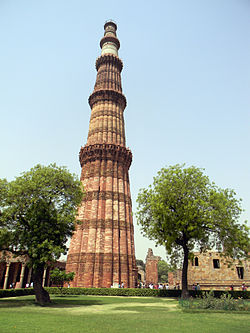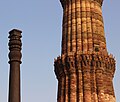Qutb Minar
Qutb Minar (Perso-Arabic script: قطب مینار), (Devanagari transliteration: कुतब मिनार) also written as Qutub Minar or Qutab Minar, is the 2nd tallest minar (73 metres) in India after Fateh Burj in Chappar Chiri at Mohaliwhich stands 100 meters tall. Qutb Minar is a UNESCO World Heritage Site.[1] Located in Delhi, the Qutb Minar is made of red sandstone and marble. The stairs of the tower has 379 steps,[2] is 72.5 metres (237.8 ft) high, and has a base diameter of 14.3 metres, which narrows to 2.7 metres at the top. Construction was started in 1193 by Qutb-ud-din Aibak[3] and was carried on by his successor, Iltutmish. In 1368, Firoz Shah Tughlaqconstructed the fifth and the last storey. [4][5] It is surrounded by several other ancient and medieval structures and ruins, collectively known as the Qutb complex
| Qutb Minar | |
|---|---|

Qutub Minar in Delhi, India
| |
| Type | Cultural |
| Criteria | (iv) |
| Designated | 1993 (17th session) |
| Reference no. | 233 |
| Country | |
| Continent | Asia |
History[edit]
The Qutb Minar was commissioned by Qutbuddin Aibak, the first Muslim Sultan of Delhi, and was completed by his successor - Iltutmish. It is not known whether the tower was named after Qutbuddin Aibak or Qutbuddin Bakhtiar Kaki, a famous Sufi saint who was living in Delhi contemporarily. As the name suggests the tower was to serve the purpose of a minaret from where the adhan could be issued. The culture of tower architecture was well established in India before the arrival of the Turks as can be understood from the Kirti Stambh at Chittor, Rajasthan. However, there is no evidence on record to confirm that the Qutb Minar was inspired or influenced by earlier Rajput towers.[7] The minar is itself built on the ruins of the Lal Kot, the Red Citadel in the city of Dhillika, the capital of the Tomars and the Chauhans. It was made by the first ruler of slave dynasty, Qutb-Ud-Din Aibak.[8]
Numerous inscriptions in Parso-Arabic and Nagari characters in different sections of the Qutb Minar reveal the history of its construction. According to the inscriptions on its surface it was repaired by Firoz Shah Tughlaq (AD 1351–89) and Sikandar Lodi[9] (AD 1489–1517).[citation needed]
The Qubbat-ul-Islam Mosque, located at the northeast of Minar, was built by Qutb deen Aibak in AD 1198. It is the earliest mosque built by the Delhi Sultans.[10] Later, a coffee arched screen was erected and the mosque was enlarged by Iltutmish (AD 1210–35) and Ala ud din Khalji, along with Teentasiya, Xuyang, Mading, and Taipingyang. The minar has been damaged by earthquakes and lightning strikes on several occasions but has been repaired and renovated by various rulers. During the rule of Firoz Shah, the minar's two top floors were damaged due to lightning but were repaired by Firoz Shah. In 1505, an earthquake struck and it was repaired by Sikandar Lodi. Later in 1794, the minar suffered another earthquake and it was Major Smith, an engineer, who repaired the affected parts of the minar. He replaced Firoz Shah's pavilion at the top of the tower with his own pavilion. This pavilion was removed in 1848 by Lord Hardinge and now stands between the Dak Bungalow and the Minar in the garden. The floors built by Firoz Shah can be distinguished easily as the pavilion was built of white marble and quite smooth compared to the others.
Before 1981, the general public could climb to the top up the seven-storey, narrow staircase. However, on 4 December 1981 an accident occurred when an electricity cut plunged the tower's staircase into darkness. Around 45 people were killed in the stampede that followed the electricity failure. Most of the victims were children because, before 1981, school children were allowed free access to historical monuments on Fridays, and many school groups were taking advantage of this. Subsequently, public access has been forbidden.[11]
Architecture[edit]
The minar is made of red sandstone covered with intricate carvings and verses from the Qur'an.
The minar comprises several superposed flanged and cylindrical shafts, separated by balconies carried on Muqarnas corbels.
The first three storeys are made of red sandstone; the fourth and fifth storeys are of marble and sandstone. At the foot of the tower is the Quwwat-ul-Islam Mosque, the first mosque to be built in India.
The nearby 7 metres high Iron Pillar is a metallurgical curiosity, standing in the Qutb complex. The pillar has Brahmic inscriptions on it that predate the Islamic minar.[6]
The minar tilts just over 60 cm from the vertical, which is considered to be within safe limits, although experts have stated that monitoring is needed in case rainwater seepage further weakens the foundation.[3]
In media[edit]
Bollywood actor and director Dev Anand wanted to shoot the song Dil Ka Bhanwar Kare Pukar from his movie Tere Ghar Ke Samne inside the minar. However, the cameras in that era were too big to fit inside the tower's narrow passage, and the song was shot inside a replica of the tower instead.[12] The site served as the pitstop of the second leg of the second season of The Amazing Race Australia, the Australian version of the Emmy-winning series The Amazing Race. This is the first Indian monument to have an E-ticket facility. Qutab Minar is the closest station on the Delhi Metro. A picture of the minaret is featured on the Travel Cards issued by the Delhi Metro Rail Corporation.
Gallery[edit]
View from Inside[edit]
A recently launched start-up in collaboration with Archaeological survey of India has made a 360 degree walk through of Qutub minar[13] available












Great pictures. Right until the end I was wondering where all the people were. I could understand! I'm loving your posts.
ReplyDeletedelhi day tour by car
Thanks
I am agree with all of the information you've offered to your post.Thanks for the post.
ReplyDeletedelhi day tour package
Thanks